Sciatica Exercises: The 4 Best Exercises
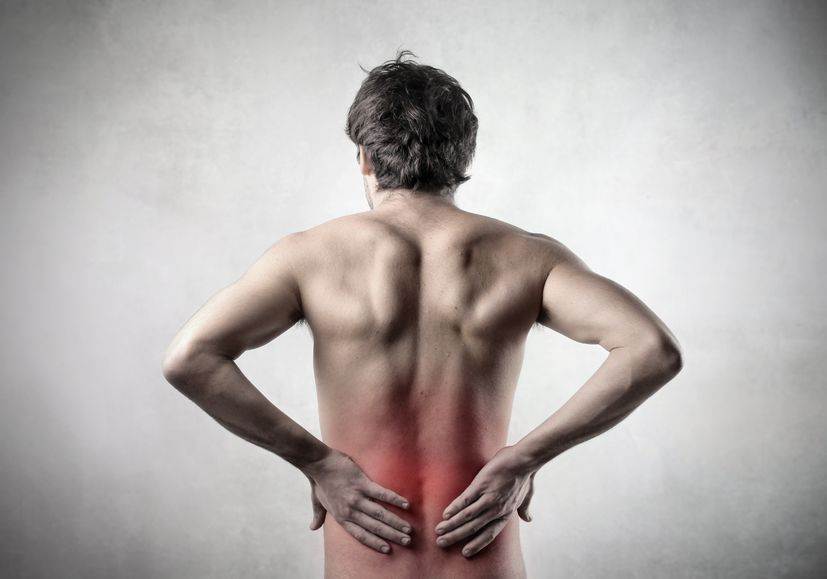
Discover the Best Sciatica Exercises for Pain Relief and Recovery
Persistent sciatica pain can transform daily activities into daunting tasks, leaving you searching for relief. If you’re on the hunt for effective strategies to alleviate sciatica and bolster your rehabilitation, welcome to your comprehensive guide. Here, we delve into not only the treatment options but also spotlight sciatica exercises that are crucial for pain relief and recovery. These exercises, when integrated with the professional care from your chiropractor or physiotherapist, are designed to reduce sciatica symptoms significantly.
Why Focus on Sciatica Exercises?
Exercises specifically tailored for sciatica play a pivotal role in managing and reducing pain. They are essential for strengthening the muscles supporting your spine, improving flexibility, and promoting healthy circulation to the affected nerve regions. This guide is your go-to resource for understanding how targeted exercises can complement medical treatments and accelerate your journey to relief and rehabilitation.
Understanding Sciatica: Sciatica Exercises
Sciatica is often described as a painful sensation that originates in the lower back or buttock, extending down through the thigh and leg, and occasionally reaching the foot. This discomfort results from the compression or irritation of the sciatic nerve. However, the root cause of this pinching can vary, necessitating precise diagnosis and tailored treatment plans.
The Complexity of Sciatica Causes: Sciatica Exercises
Identifying the exact source of sciatica is crucial, as nerve compression can occur at multiple points along its path. Misdiagnosis or oversimplification of your condition as merely “sciatica” without further investigation can lead to ineffective treatment strategies. It’s essential to understand whether the pain stems from issues like disc herniation, degenerative disc disease, or another underlying cause to ensure the appropriate therapeutic approach is employed.
See Also: Best Toronto Chiropractor: How To Find The Best Chiropractor In Your City
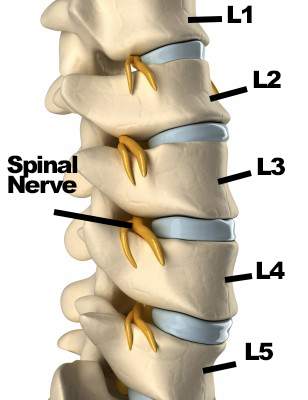
L4 and L5: Sciatica Exercises
So how do I know where my pinched nerve is? Two nerves come out between the last two vertebrae in your body. Your nerve is very commonly pinched here.
Your lower back vertebrae are called lumbar vertebrae. There are 5 vertebrae in the lower back. Taking the “L” for the lumbar spine, they are named L1, L2, L3, L4, and L5. The last two vertebrae in your lower back are L4 and L5.
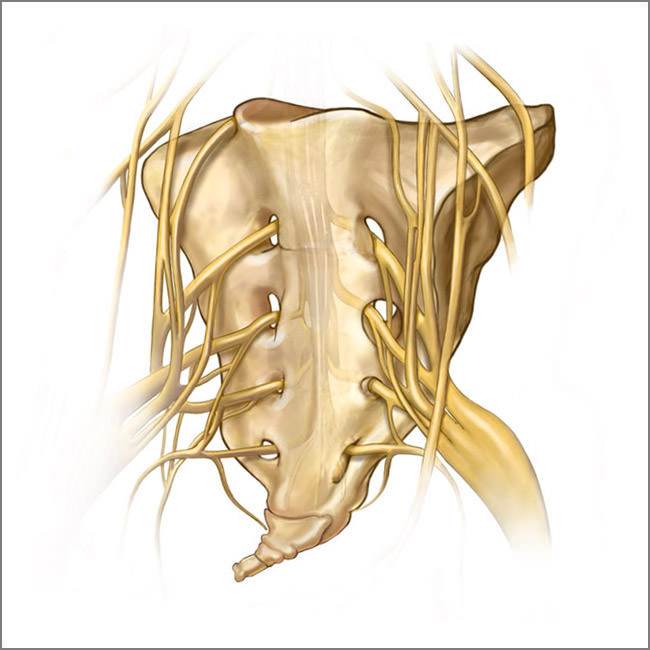
Ion medical designs http://www.ionmedicaldesigns.com/ion_site/two_dimensional_artwork.html
Just below L5 is one of your pelvic bones. It’s called the sacrum. The sacrum has holes with yellow-coloured nerves coming out.
S1, S2, S3: Sciatica Exercises
The nerves are called S1, S2 and S3. “S” is for sacrum. These nerves are rarely pinched.
Your sciatic nerve is formed when the nerves from L4 L5 and L5 S1 join together with the S1, S2 and S3 nerves in your buttock.
So, most of you will have your nerve pinched in one of three spots.
- In the buttock the Sciatic Nerve starts, in other words where the S1, S2, and S3 nerves join the two other nerves that come out between L4, L5 and L5 S1.
- Between L4 and L5 vertebrae
- Between L5 and S1 vertebrae
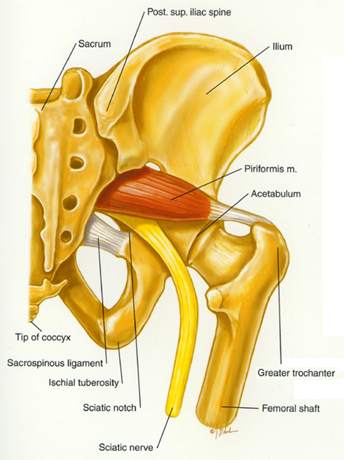
Now you know where the nerve can be pinched but it doesn’t answer why one of the nerves is pinched causing your sciatica
The Usual Suspects (Causes) of Sciatica
Most people’s sciatica is from:
- Herniated Disc at L45 or Herniated Disc at L5S1 (some osteoarthritis = “wear and tear” is involved)
- Degenerative Disc Disease (Osteoarthritis of the Disc=”Wear and Tear” of the Disc)
- Stenosis (Basically advanced osteoarthritis)
- Spondylolisthesis (A fracture of the vertebra or Osteoarthritis with the vertebra moving forward)
- Piriformis Syndrome
These are the diagnoses that your doctor or chiropractor should be telling you about not sciatica.
Remember sciatica only says that you have a pinched sciatic nerve causing pain in your buttock and leg, sciatica doesn’t tell you the cause of your pain. Without determining the cause you will get hit-or-miss treatments from your chiropractor or physiotherapist as they can’t give you specific treatment.
See Also: MRI CT scans X-rays, What’s Best For My Pain
The key exam that you need to determine what the heck is causing your pain is a neurological examination. You have probably seen it on TV before.
- Reflex tests with a reflex hammer on your knee and the back of your ankle
- Muscle Strength Testing: Resisted muscle testing of your foot. You try and push up/down while the chiropractor holds your foot. An alternative is heel walking and walking on your toes.
- Light Touch and Sharp Dull Testing: A light touch directly on the unclothed legs and feet to determine if you are unequal in your sensitivity to light touch and sharp/dull testing. A light touch is often enough as a screening.
Also, remember that the diagnosis should pretty much be determined in the office and X-rays, MRI, and CT scans done only if there are signs of something else or the diagnosis is kind of fuzzy.
See Also: Herniated Disc Part 2: The Best Exercises For Your Herniated Disc
Herniated Disc: Sciatica Exercises
You herniate a disc from the everyday habits that you have. The everyday habits of slouching and bending with a rounded low back, build up to weaken and damage the disc to the point it is ready to break open and herniate.
The problem is there is no pain. You don’t feel sciatica until the disc has herniated as there are no nerves inside the disc. So you continue your habits and think you don’t have a bad back until one day you lift your daughter off the floor.
The only problem is you had a bad back with no symptoms for a very long time. This is just like a car with a little bit of rust showing but if you take the car apart you see a lot more rust.
Degenerative Disc Disease – Osteoarthritis of the Disc
Degenerative Disc Disease is a continuation of the breakdown of the disc that was started by bad lifting and slouching habits.
The disc becomes smaller, and brittle like an old elastic band that is decaying, leading to the disc becoming smaller in height. The smaller disc makes the space between the vertebrae smaller. Thus, your nerve doesn’t have much room, so your nerve gets pinched between L4 and L5 or L5 and S1.
Stenosis- Most commonly from continuation of Osteoarthritis
Stenosis is a “narrowing”. There are two types of stenosis
- Lateral Stenosis
- Spinal Stenosis
1. Lateral Stenosis is the narrowing of the hole which the nerves from the spinal cord come from. Does this sound familiar? It’s degenerative disc disease + the bone degenerating forming spurs that narrow the hole for the nerve. A smaller hole for your nerve eventually means a pinched nerve.
2. Spinal Stenosis is the narrowing of the canal where the spinal cord sits. This is essentially pinching of the spinal cord usually in the lower back.
Spondylolisthesis (Vertebebra moving forward)
Spondylolisthesis is usually the moving forward of the vertebra (sometimes backwards). When the vertebra moves forward the spinal cord and nerves are pulled putting tension on your nerve. Nerves under tension get irritated and so turn into sciatica. This can happen from a fracture to the vertebrae or osteoarthritis.
Piriformis Syndrome
Most people’s sciatic nerve usually goes over or under the piriformis muscle. In some cases, possibly yours, the sciatic nerve goes right through the piriformis muscle. When the muscle tightens up it squeezes on the sciatic nerve causing sciatica.
Walking like a “man” is another reason for sciatica. That’s right, when you walk bow-legged with your feet turned can give you trouble later.
Chances are, if you are reading this you already have a problem with sciatica. When you turn your feet out this makes the piriformis muscles work harder.
The harder your piriformis works the more likely the nerve will be pinched causing sciatica.
The 4 Best Exercises For Sciatica
While treatments are different for sciatica depending on the cause you can still help your chiropractor or physiotherapist by doing your home exercises.
1. Flossing: first introduced by Michael Shacklock
Flossing is good for your teeth but a different kind of flossing is good for your spine and spinal hygiene.
First, determine if you can floss safely:
- Sit on a chair or relatively hard surface. Please don’t sit on the couch, it is too soft and will aggravate your lower back.
- Raise your painful leg to the point of pain and keep it there.
- Bend your neck forward till your pain is aggravated from above
- Lower the leg till the pain decreases.
If the pain decreases you are safe to do flossing.
Warning: This exercise can cause acute sciatica but chances are minimized by doing the screening exercise. Don’t floss until you have been out of bed for at least 2 hours. Now The Flossing:
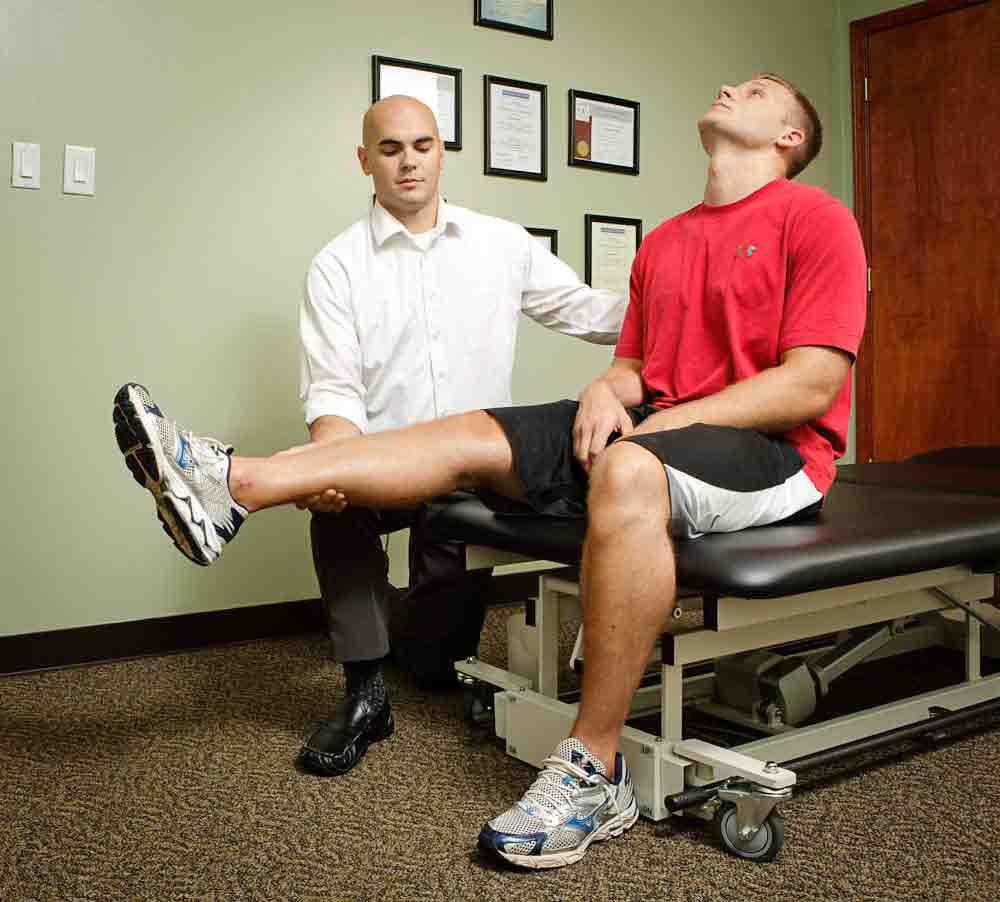
- Sit down in a chair with your legs swinging freely
- Bend your neck forward for 5 seconds (if this doesn’t cause sciatica you can do the next step)
- Bend your neck backwards as far as possible and straighten the knee (5 seconds)
- Repeat 3 sets of 10X on each leg. You can do this for up to 5/day.
2. Piriformis Stretch A) Sitting and B) Lying Face-Up
A: Sitting:
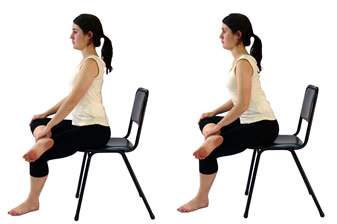
- Sit in a chair and cross the bad leg over the good
- Keep the arch in your back and move your chest forward
- Repeat 3 sets 30 secs. This can be done several times a day
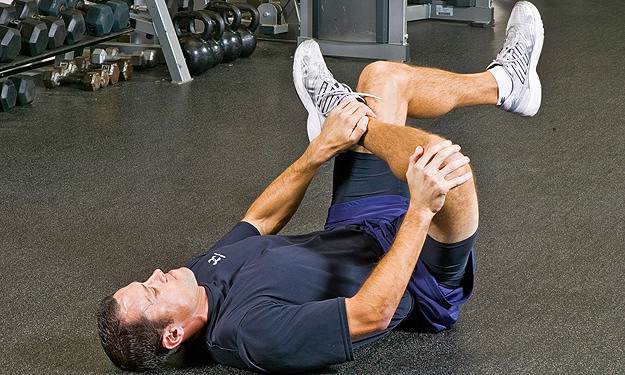
B: Lying Face-up: This exercise might be easier for some of you.
- Lying Face-up both knees bent. Put the bad leg over the good.
- Bring the good leg up to support the bad leg.
- Push the bad leg outward.
3. Ball Exercises: Piriformis, Gluteus Maximus, Gluteus Medius
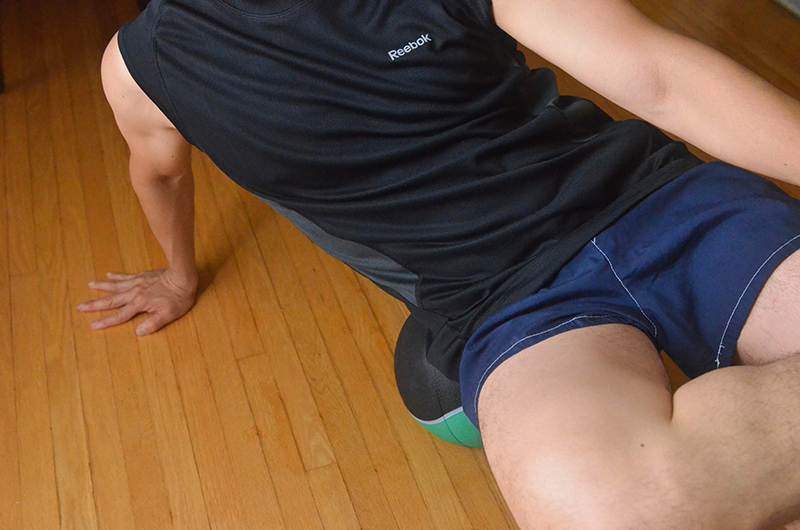
Piriformis
- Cross your bad side leg over the other knee
- Get a tennis ball, basketball or a medicine ball and sit on it with your buttock.
- To treat the piriformis go lean at about a 45-degree angle.
- Stop at each tender point and hold until each one is ironed out or feels less tender.
Gluteus Maximus
- Same as the piriformis except that you don’t need to cross the bad over the good.
Gluteus Medius
- Same as Gluteus Maximus except that you now lean at almost a 90-degree angle -You are almost on your side with a focus on the side area just below the belt or hip bone
4. Cobra
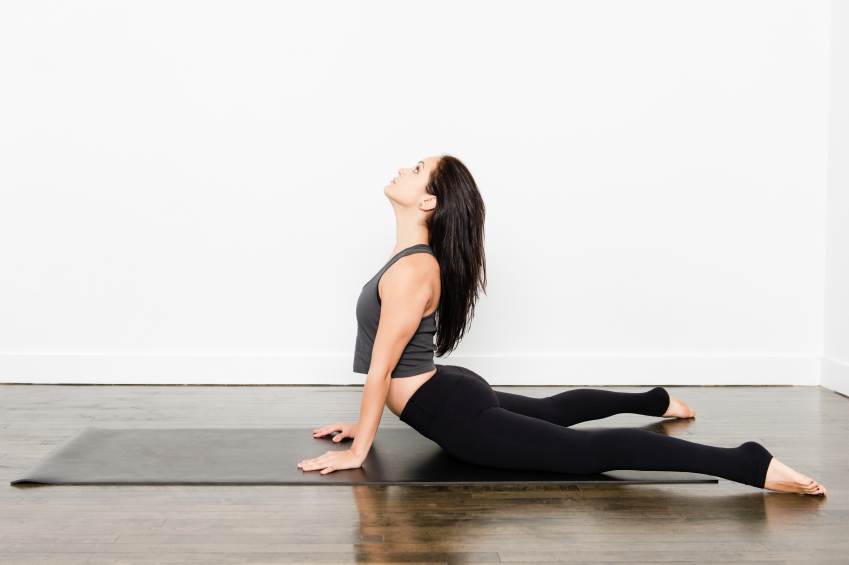
- Lie down face down with your hands underneath your shoulders.
- Push up from as high as you can until your lower back stops you or your elbows are straight.
- The pelvis should still be on the floor and the lower back muscles relaxed.
- Do these exercises hold each time for 1-2 seconds 6-8 times per set? This exercise can be repeated every two hours throughout the day.
If your pain is from a disc herniation you can combine the disc herniations part 2 exercises with these exercises. If your sciatica is from a different cause I will write about all the conditions that cause sciatica over time.
Write in the comments to tell us how you are doing with your sciatica. Also, let us know your vote for the best Toronto Chiropractor below. Connect with me on LinkedIn.
Related Categories: Disc Herniation, Elbow, Hip, Low Back Pain, Shoulder, Stenosis


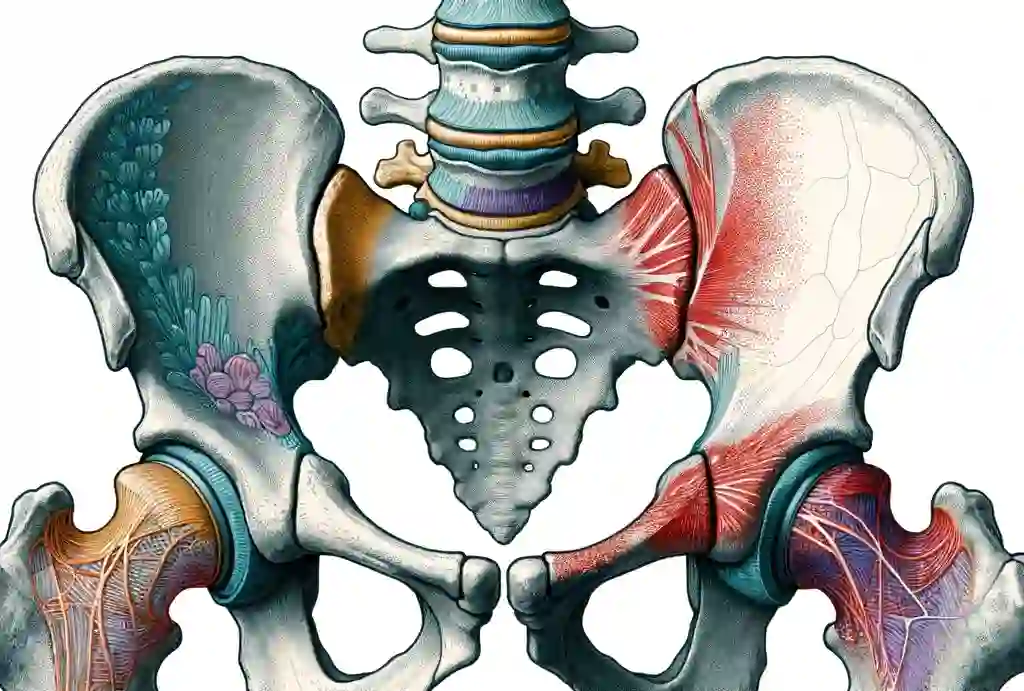

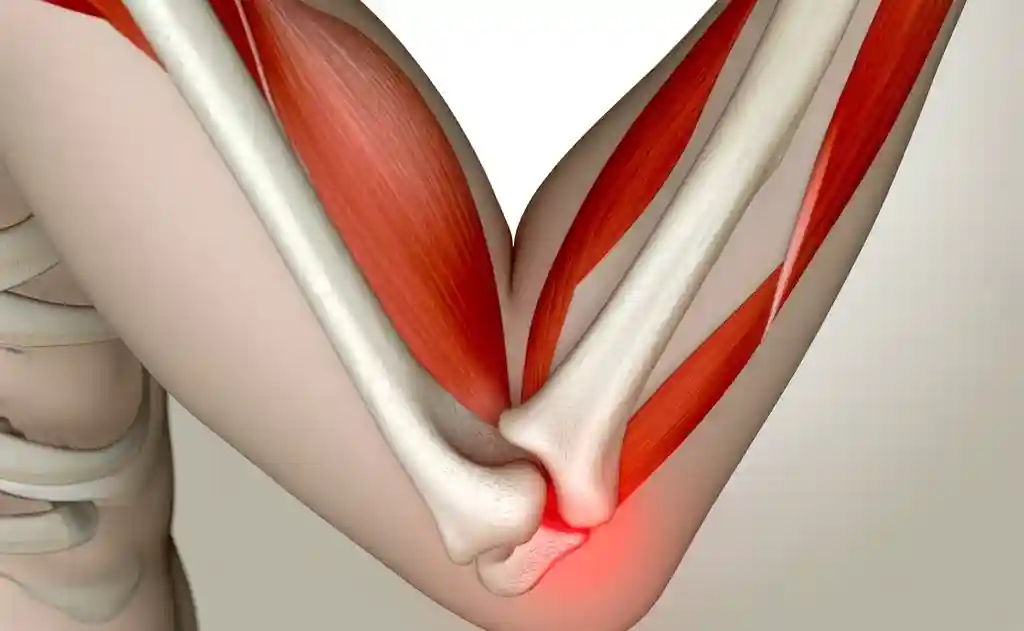
i have 2 herniated disks l4l5 …. i love bodybuilding very much and i’m affraid that i won’t be able to lfit weights again …. the pain is only when waking up in the right leg and when i walk it releaves in about 10 minutes … i didn”t workout for 25 days and my question is can i lift weights again and how much time is it going to heal and what exercices should i avoid if lifting again …thnx doctor i really need an answer
and doctor i did a scanner and the results was : -posterior medial disc herniation conflict of l4l5 floor
– Sacralization transitional anomaly atype of l5 …..
Author
Thanks for your question Fourzi. Most people can get back to doing weights again. However most people do squats and deadlifts wrong. Also bent over rows and most ab exercises will contribute to a disc herniation. If you have a common type of problem disc herniation.
Your recovery time is dependent on so many variables and I cannot tell you as you need to be much more detailed with your symptoms and history. Again I can’t give you exercises without more details.
Hope you understand I need to be responsible when making recommendations about disc herniations of l4l5 or any other diagnosis.
Will really try the exercise for L5-S1 related case. Was diagnosed of that lately and I have been looking for a way to help myself with a few exercises and I think these ones would be helpful.
Hope the exercise will help correct the reduction in the L5-S1 disc space.
Thanks Dr. for sharing it.
Author
Thanks for your question. I wouldn’t do the exercises quite yet. It’s better if you tell me what your symptoms are in detail before doing the exercises.
Hope you understand that what you see on imaging isn’t always the diagnosis.
Hello Dr. Ken,
I have L4, L5 disc issue. This disc is bulging out and compressing the nerve. Also my entire left or at time entire right lower half pains due to nerve. I have consulted 3 doctors out of which 2 have recommended operation and one has asked me to hold on and take medication for 3 months. I am currently on medication. if i skip a dose, the pain terribly comes back. I dont know what should i do. Can you please give your opinion?
Thanks
Ranjita
Author
Thanks for your question Ranjita. You should be doing conservative therapy supervised by a health practitioner. Unless it’s an emergency operation you should be doing conservative therapy with a chiropractor or physiotherapist. Medication is great at covering up the pain and so helpful when you need it, but medication doesn’t treat the problem.
You can also do these exercises. https://www.bodiempowerment.com/herniated-disc-part-2-the-best-exercises-for-your-herniated-disc/
If the pain gets worse or symptoms like numbness, tingling or pain goes further down the leg than you are getting worse. This mean you need to stop the exercises.
Hope that helps your possible disc bulge at L4, L5.
Hi Dr. Ken
I have disc bulge in L34 L 45 and L5S1, what kind of exercise is good for me?
Author
Thanks for your question Ali. You need to tell me what is wrong with your back and symptoms in detail. It’s like you as a consumer telling an auto mechanic I have a engine problem tell me how to fix it. Well a proper diagnosis has to be made. MRI by themselves are not a diagnosis. They are only a scan and not very smart. For example a disc herniation will not put pressure on the nerve in a MRI. In real life they often do. Why? We know for a fact that when you sit there is more pressure on the disc. When lying down in the MRI machine the pressure on the disc is reduced so your report will say there is no pressure on the nerve from the disc.
The MRIs are dumb and you have to have a person interpret it properly. Also 30% of 30 year old have disc herniations with no pain. So is your disc bulge causing your pain. Maybe, maybe not.
You need to tell me a lot more.
Hope that helps your understanding of sciatica and disc herniations.
Thanks for reply
I was suffering from sciatica pain for almost 7 months, and the pain some time goes down to leg and there is also pain in lower back. Then i went to neurosurgeon and he told me to do MRI. In MRI he found disc bulge in above mentioned discs specially to the left side but i fell pain in both legs. Some time hip joints make more pain even i can’t walk/sit and some time it become normal every thing. My Dr. Told me about forward bending and twisting exercise but i am worried as on internet i read in to many places that forward bending and twisting exercise is not good for bulgin disc. I will also post full MRI Result by tommorow.
Sorry For My Bad English. But i hope you will understand.
Author
Thanks for your question Ali. Forward bending may be helpful for some types of disc herniations but they are not very common. Unless your doctor did a thorough examination and is trained properly it is almost always the wrong thing to do. You may be one of the exceptions but not likely. Try these exercises. https://www.bodiempowerment.com/herniated-disc-part-2-the-best-exercises-for-your-herniated-disc/
If the pain gets worse or any numbness, tingling or pain goes further down the leg then you are getting worse. You then need to stop the exercises. These exercises should be supervised by a health professional at least initially.
Hope that helps your sciatica Ali.
Thank you Dr.,
I’ve visited the acupuncturist a second time(all I could afford). I did stop when feeling the tingle. Since the second visit, I no longer feel the tingle but it’s tight like it was before. I’d really rather avoid surgery… I’ll try the stretches in this article. I’m pretty sure it’s a bulging disc. Is there no way for the disc to get back into its original position without surgery? I mean, I’d really like this issue to be cured permanently of course, but it sounds like through stretching all I can do is relieve some pain, am I wrong?
Again, thank you so much for your time and input, especially through this holiday season.
With admiration,
-Charles Coffman
Author
Thanks for your question Charles. Why don’t you do these exercises instead. https://www.bodiempowerment.com/herniated-disc-part-2-the-best-exercises-for-your-herniated-disc/
IF the exercises make the pain, numbness or tingling go further down the leg then you should stop the exercises. However if the leg pain decreases and the back pain increases you are actually getting better. These exercises should be supervised by a health professional.
Hope that helps your sciatica.
Thank you Thank you. ? Thought I should throw an extra one in there in hopes that you understand I very much appreciate it.
Author
You are welcome Charles.
Wow, just about two years later and you’re still responding. Phenomenal.
Maybe you don’t mind a request for your input for my particular situation as you’ve helped so many before…?
I’m 33, I’ve been young and dumb once. In 1999-2000 I performed what I thought to be a cobra stretch. I pushed too hard and felt something “pop” in my lower back. I’m not sure which unit exactly and I’ve never seen a doctor or taken an MRI. It’s been very mildly aching…I wouldn’t even call it pain, more like an annoyance. I have since “mastered” the cobra.
The nerve, since then, has prevented stretching as far as I used to but never caused pain while stretching. No numbing, no tingling, just kind of tight.
I’ve visited an acupuncturist who is very well versed in his craft with 30+ years of experience and studied in China. He is also Chinese which may or may not be relevant…I personally believe it is. It was my first time ever seeing an acupuncturist and first time seeing a professional about my nerve. This was just a couple days ago, dec 16 2015.
The next day I went to do my stretch routine and found a shooting tingle the whole length (from lower back to toes) when I got to hip rotations(standing). First time I felt it tingle. Was not painful.
I’m thinking that maybe I’ve been suppressing this nerve for so many years and now that I’ve had a chance to visit the acupuncturist, he’s helped me to open up the nerve’s “channel” so to speak, and now it’s finally ready for healing. I’m not sure if I should stretch through that tingle and essentially “be” with it or not…for the sake of being safe, I backed off when I felt the tingle.
Seeing how you’ve clearly studied the back and spine quite extensively, I’d like to ask what your thoughts on this might be.
I really appreciate it
-Charles Coffman
Author
Thanks for for your question Charles. The basics are that when you feel pain, numbness or tingling going further down from the back you are getting worse. So if any symptom mentioned before is going to the buttock bad, to the knee worse, to the toes is the worst. So the answer is yes you should stop when you feel the tingling.
Don’t be one with getting worse. Be one with getting better.
Hope that helps your sciatica.
i am 25 years old a photographer between few months i feel back pain then i goes to doc he give me some medicines but its cant relief me then doc suggest for x-ray in reports of x -ray there are 2 dots scoilosis on my hip joint doctor says that is symptomp of tb then they suggest me mri and screening 2 days ago i done this test when i show the report to doctor they told me that my spine l4-l5, l5-s1 disc is compressing my vein so he suggest me operation for this after this i will show same report to another doctor he told that physiotherepy can give relief to me ,another doc say for operation again i am totaly confuse i am not in position for operation please suggest me is this possible without operation
Author
Thanks for your question Bharat. If the problem is not an emergency than getting conservative treatment like chiropractic or physiotherapy is most appropriate. Don’t go back to the other two doctors as that is not the correct procedure. Again assuming that this is not an emergency.
There are very few exceptions to the rule to get conservative treatment before getting surgery. Scoliosis that can be possibly causing low back pain is not an exception.
I am starting to suspect that if you are from India or Pakistan that doctors there have something to gain like Baksheesh from the surgeon as large percentage of the comments from there have doctors referring people to surgery with no conservative therapy before hand. This is simply wrong.
Where are you from?
Hope that helps your confusion.
thank you. i am from india
Author
You are welcome Bharat.
I am 32 years old. From 1 years i am feeling numbness from waist to lower portion of my body. Even i can not walk for 5-10 min continuously. one of my friend suggestion i did MRI and as per my doctors recommended i regularly doing zim but after 3 month no improve i notice. i also have scoliosis by born. Please see the below MRI reports:
# gross scoliosis of lumber vertebrae with convexity towards left is noted.
# Forward slip of L5 over S1 noted.
# L5-S1 disc shows dehydration.
#Disc space is reduced at L3-L4 & L4-L5 with end plate sclerosis.
# Marrow signal intensity found normal.
# At L5-S1 Level : posterior disc herniation with scoliosis causing thecal sac indentation, severe canal stenosis, bilateral lateral recess with foraminal narrowing & corresponding nerve roots compression.
#No pre and paravertebral lesion detected.
# Visualizer cord shows normal course and caliber.
Impression: MRI finding of Lumber spine:-
#Gross scoliosis with convexity towards left.
#Grade 1 forward listhesis of L5 over S1.
#Posterior disc herniation with scoliosis causing thecal sac indentation, severe canal stenosis, bilateral lateral recess with foraminal narrowing & corresponding nerve roots compression at L5-S1 Level.
Please suggest me what should i do now. Your suggestion will be highly appreciate.
Thanks
Jaman
Author
Thanks for your question Jaman. You should try these exercises. https://www.bodiempowerment.com/herniated-disc-part-2-the-best-exercises-for-your-herniated-disc/
These exercises should be supervised by a health professional. If the pain or numbness or tingling goes further down the leg you are getting worse. At that point you should stop the exercises.
Hope that helps your disc herniation.
Hello doc recently when i did mri of lumbar spine as i was having a chronic pain i got this report…
Broad based L5 s1 disc bulging asymmetric to the right abutting and impinging upong emrging the right root S1 root.
Subtle L4-5 disc prominence abutting both L5 roots.
Its a minor slip disc doc said…
I wanted to know will this cure?? I mean will it be seen normal when i do mri after 1 year when there is no pain
Author
Thanks for your question Ajinkya. First don’t get hung up about getting a normal MRI. It’s not the MRI you want to cure it’s your back you want to help. Also the disc may not be causing your pain.
I can give you recommendations as you told me nothing about your pains and only about your MRI.
Hope that helps you to realize I need to know about you not just your MRI. MRI’s by themselves our terribly misleading.
Dear sir
I have a back pain last 4 month . I cant able to walk more then 5 min .and that pain is up to my left buttx and hole left leg . I cant able to stand more then 5 min .doc says your l4 l5 disc are mild bulge .and s1 narves thats why its happ .pls sugessted me to some exesics and wat can i do
Author
Thanks for your question Arvind. Sound like you need professional from someone that can examine you.
Hope that helps your sciatica.
sir,
I have modic type 2signal intensity change at L endplate area.
I have l5 s1 disc herniation(protrusion) with disc dessication at l5 . this is causing compression to nerve and burning pain in right sided hip,thigh and leg .
i am suffering from this problem since jan 2015.
Pls advise me for specific exercises for my condition..
thank u very much in advance
Author
Thanks for your question Vinod. MRI results don’t usually correlate so I cannot give recommendations based on MRI results alone they are misleading which causes many doctors and chiropractors to diagnose based on MRI. A great way to misdiagnose you.
You need to give more information Vinod. Hope that helps your possible disc herniation.
Hi Sir,
I have some problem while walking feels like pulling me left side and legs are pulling down ..un easy while walking …( weakness and tingling in the leg) . I do not have pain any ware . I contacted the doctor, he asked me to take MRI spine .. it says L4 L5 disc bulge, I am practicing yoga and physical therapy… it is around 4 months not much improvement , I keep on changing the doctors .I have tested every thing in the body .. all the reports looks fine. since this happened I stopped drinking coffee , alcohol and also reduced smoking.
please help , thanks a lot
Author
Thanks for your question Thilek. I recommend you have these exercise supervised by a health care practitioner. https://www.bodiempowerment.com/herniated-disc-part-2-the-best-exercises-for-your-herniated-disc/
If the numbness, tingling or pulling get worse or go further down the leg than you should stop the exercises.
Hope that helps your possible disc.
thanking u sir for replying,
i feel burning nerve pain in thigh,right side of hip in right leg only when sitting or more than 10 minutes. i feel burning nerve pain near right leg ankle hen walking for more than 5 minutes,
from 15 september this problem exist and burning intensity reduced after doing cobra exercise, bird dog and sphinx pose .. but i am still in so much burning pain .. i have disc bulge at c4-c7 level also.
so kindly suggest if i can hang in a bar for reducing back and leg pain although i am having disc bulge at c4-c7 level but no compression..
pls sugest other exercise that i can do.. i feel good after doing exercises suggestd by u.
kindly suggest if i can hang in a bar for reducing back and leg pain although i am having disc bulge at c4-c7 level.
thanking u sir
Author
Thanks for your question Vinod. If you mean you can hold onto a horizontal bar with your feet not touching the floor you can do that. Providing the disc bulge is not giving you symptoms. Many people do not have symptoms even though an MRI shows disc herniations. Don’t let the MRI cause you extra distress.
Hope that helps your leg pain possibly from a disc herniation.
Hi dr ken
I have right para central caudally migrating disc extrusion manifeted as right sciatica along the whole course of sciatic nerve since 1 month
I cant stretch my leg or sleep prone
I try the stretching and prone exercise (i feel the pain along the whole course ) .however it is tolerable
You think i ll have a benefit from the exercises ???? (I started just 2 days ago)
Or it will be harmful…and discectomy is the treatment of choice????
or
Author
Thanks for your question Dr. Mostafa. When feeling the pain along of the nerve that means that you are irritating the nerve and that is what I call peripheralizing. Try these exercises first https://www.bodiempowerment.com/herniated-disc-part-2-the-best-exercises-for-your-herniated-disc/
If the pain goes further down the leg than you are getting worse. Even numbness and tingling going further down the leg means you are getting worse. If the pain is worse in the lower back but symptoms are going up further in to the leg than you are getting better.
The good news is that body will likely reabsorb some of the extrusion in about 6 months time or longer. Results of research shows that after 2 years people with and without surgery the disc looks the same on MRI.
Hope that helps your disc extrusion.
Dear Doctor,
I have problem with my L5S1 and am unable to bend forward. This started gradually when I was having difficulty in wearing socks. But then it got worse and I could not wear at all. Now bending is very difficult, feels like locked at the waist. I can bend slowly to about 30 degrees or so. Also, cannot raise my left leg higher, it seems locked also. And I feel pain when I put weight on my left leg, making it hard for me to climb stairs, etc.
MRI report says “Degenerated and Protruded L5-S1 disc causing indentation on theca”. No pain when sitting or sleeping, but when I get up from sitting position, I get pinching pain on my left foot for few minutes.
What exercise would you recommend and if any other advise you may please have to help me?
Thank you very much
Author
Thanks for your question Kirit Try these exercises. As with any exercises they can make you worse. If the pain or any other symptom like numbness, tingling, or pain goes further down the leg than you are getting worse. You should than stop These exercises should be supervised by a health professional.
Hope that helps your disc herniation.
Dear Dr. Nakamura,
Thanks. But what exercises? I did not see any links. Please help.
Regards
Kirit
Author
Sorry about that Kirit. https://www.bodiempowerment.com/herniated-disc-part-2-the-best-exercises-for-your-herniated-disc/
That is the link that I forgot to post.
Hope that helps your sciatica.
Thank you doctor. I have started the exercises today.
I would like to request you to please let me know if massage helps in my situation. Also, is it necessary to sleep on a flat and hard surface at night to bring relief to te back and sciatica?
Once again, thanks and God bless you. Kirit
Author
Thanks for your question Kirit. Massage is helpful for most sciatica. Also sleeping on a hard surface does help most people with sciatica but not all. You just have to try and see. I had a patient put a wooden door underneath his mattress to “harden” his bed which helped him greatly.
So you don’t necessarily have to sleep on the floor.
Hope that helps your sciatica.
sir I have pain in left buttock for four years. my MRI remarks are :the MR imaging features reveal disc desiccation and small left paracentral herniation at L5-S1 level indenting the thecal sac with minimal lateral recess compression of left S1 traversing nerve roots. please advice remedy and exercise.
Author
Thanks for your question Raushan. Sounds like you were diagnosed by MRI and not by a proper examination and history. MRI can be very misleading as most findings on an MRI are not causing pain or any symptoms what so ever. Too surgeons recommend surgery based on MRI and not based on their examination and history.
I would get hands on therapy by a chiropractor or if none are available a physiotherapist.
Hope that helps your buttock pain.
Hi Dr. Ken
This is Tajinder 30y Male.
I have lower back pain and pain in buttocks.
Here is my MRI report.
the l4-l5 level shows mild degenerative changes including discspace narrowing disc degeneraion, osteophyte formation and facet hypertrophy. ther is a small extruded broad based disc herniation contributing to significant moderate central spinal stenosis. Ther is no evidence of nerve root impingement.
the l5- s1 shows mild degenerative changes.there is also a small extruded central and left disc herniation causing significant left s1nerve root imoingement. there is moderate central spinal stenosis
the remainder of the lumbar spine shows trivial degenerative changes.
It has been from almost a year
I had massgae therapy and having physiotherapy.
There is improvement but still have issue mainy in left side lower back.
I feel pain mostly when i lift the left leg and I cannot sit on floor with left leg spreading straight on floor, some times i could do but with effort.
Could you please suggent me what I needs to do?
Is swimming is good in this case.?
Is this fully curable?
Please suggest me
Regards
Tajinder Singh
This is the BEST website I have seen in hours of desperate searching! Thank you Dr Ken!
About two months back I developed severe pain in my entire right leg from buttock to the last two toes of the foot. I had zero back pain. Only later I realized I have sciatica. I consulted a couple of doctors here (a neurologist and a orthopedist) who seemed not at all competent and conducted minimal physical examination, but were very eager to go for MRI and surgery. One doc even spelled “SLR” ans “SRL”! Luckily I saw your website while waiting for the MRI. I excused myself and came home! After doing the sphinx and cobra exercises the pain has definitely reduced, thank God and you!. The shock-like toe pain has mostly gone. During the day I have a little pain, mostly in the back of the thigh and sometimes calf and inside buttock. When I sit for a longer period the pain increases as soon as I get up, and goes away after a few minutes. But what is worrying is the extreme pain in the morning when I get to my feet. Going to the bathroom is an agony. This pain lasts about 45 minutes and by one hour has mostly gone. There has been NO change in the intensity of this pain even after three weeks of your exercises. The one change is that the toe pain has gone, but the pain thro the back of my leg is still there. Is there anything I can do to address this problem. Thanks for your kind help, Doc.
Author
Thanks for your question. Sorry about the late response was on vacation. First in the morning lie down in your front before getting up out of bed. Then do the sphinx exercises. If that is OK and doesn’t give you pain down the leg than do the cobra. The cobra can make you worse so don’t be aggressive with it. Here is the link to the exercises: https://www.bodiempowerment.com/herniated-disc-part-2-the-best-exercises-for-your-herniated-disc/
Hope that helps your disc herniation.
My MRI impressions are:
1. Central and right paramedian disc protrusion at L4-L5 level with right L5 nerve root compression.
2. Central disc protrusion at L5-S1 level.
3. Degenerative changes with mild right L4-L5 and L5-S1 neural foraminal stenosis.
4. Early degenerative changes in cervical spine.
So I consulted with two doctors. One a spine surgeon who suggested me an injection followed by therapy. While the other was neurologist, who suggested me an operation. As I’m an architecture student, operation procedure seems too time consuming as my exams are coming and I’ve my projects to submit. I’m having severe pain in my right legs at nights and sometimes while walking. My right leg is comparatively weak than the left one. So what should I do? Please help me out. What will happen if I operate after 1.5 months? Is operation the only option?
Author
Thanks for your question Varsha. Anyone who doesn’t recommend therapy first is questionable from my point of view with the information I have so far. Unless your case is an emergency, which it clearly isn’t than I would do your therapy first. You can always do the therapy first than if that doesn’t work I would do the injection followed by smaller series of treatments. Than I would try a different practitioner.
Hope that paramedian disc protrusion at L4-L5
My wife have problem of disc protrusion since last 2 months. MRI shows left para central disc protrusion of L5-S1 indenting traversing left S1 nerve root. she suffered more pain at night in her both legs. She had also sever pain at lower back. We are trying massage therapy since last 1&1/2 months. But no improvement noticed. We consulted orthopedic doctor also but he said that take full bed rest and medicines of pain relief. We had also tried hot water bag but no improvement. Please give me best treatment options for this.
Author
Thanks for your question Rakesh. Try these exercises. https://www.bodiempowerment.com/herniated-disc-part-2-the-best-exercises-for-your-herniated-disc/ They should be supervervised by a health professional as they can make you worse if done improperly.
Hope that helps your possible disc protrustion of L5-S1.
I’ve had burning in buttocks that’s pain ful when sitting and laying. For 4 months, 2 months of chiro and traction. Had injections in si joints w/out Dr. Reviewing my MRI , they irritated my sciatic nerve worse. MRI says l3-l4 posterior disc bulge central protrusion bilateral mild facet arthropathy. L4-l5 broad based posterior disc bulge with DIsC material encroaching into foraminal zones, causing bilateral mild (but looks like it’s taking up most space on left foraminal) l5-s1 posterior central disc protrusion hyper intense annular tear.. Also general comment mild/moderate subcutaneous degenerative spondylisis of lumbar spine most l3-l4 level… I can’t get my dr to give me referral to neurosurgeon she hasn’t looked at MRI and pain managment doc didn’t either just guessed si joints we’re cause of burning, is it safe to do exercises with tear and encroached foraminal at l4-l5? Should I try another chiropractor ? Or try to find an independent neuro I don’t need referral for, my insurance doesn’t require referral but hospital won’t let me make an appt w/. One, any advice appreciated 38 yrs old 110 lbs healthy but homebound last 4 months from pain
Author
Thanks for your question Angel. I would go to a chiropractor that does rehabilitation. You can also do these exercises here https://www.bodiempowerment.com/herniated-disc-part-2-the-best-exercises-for-your-herniated-disc/
They are likely to make you worse though. I would only do them with guidance from a health practitioner.
Hope that helps your disc herniation.
Hi, I know your busy I’ve read many of your messages, thought you might be able to advise me, I’m due to go into hospital this Saturday 18th July. I have a collapsed disk l5 s1, I’ve decided to go ahead with the option of try the injection first before having to go through an operation, the doc said there is a 60-70% chance of success . Now my question is firstly will I be able to return to my job wich is working in a casino as a dealer so I’m always bending across tables collecting cards and chips , which I found almost impossible to deal the game craps because the stretching was to much, but this is my concern can a carry on doing what I do, also is it safe to ride a bike , pedal one?
Author
Thanks for your question Roy. What I recommend is that assuming you have already tried exercises, after the injection try the exercises again. If you haven’t tried exercises you should try.
https://www.bodiempowerment.com/part-2-degenerative-disc-disease-exercises-help-lower-back-pain-spondylosis/
( I am assuming when you say collapsed disc that your disc has decreased in height and is not herniated or prolapsed)
Make sure the exercises are supervised by a health care practitioner like your local chiropractor.
Hope that helps your